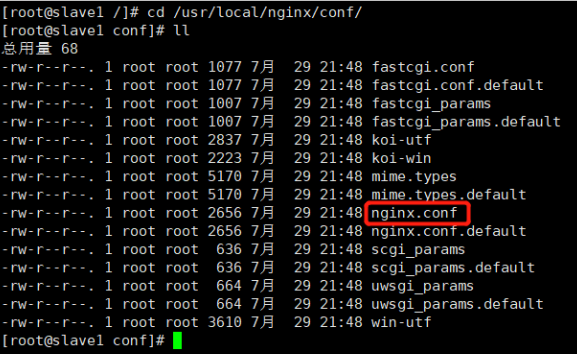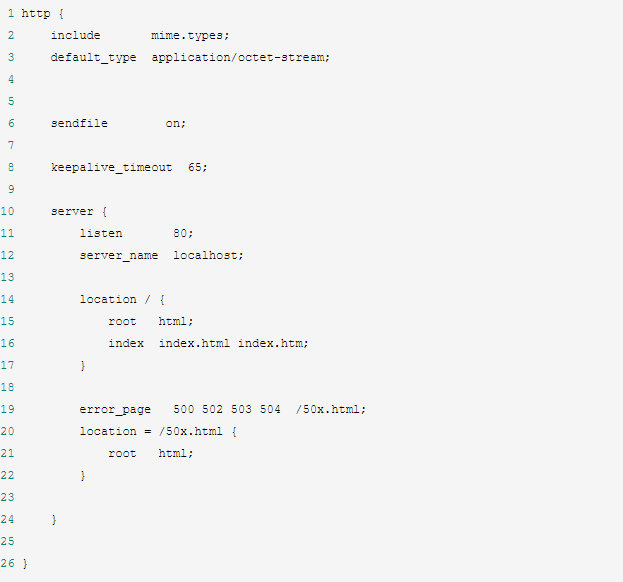Nginx 配置文件
一、nginx.conf 配置文件
nginx 安装目录下,其默认的配置文件都放在这个目录的 conf 目录下,而主配置文件 nginx.conf 也在其中,后续对 nginx 的使用基本上都是对此配置文件进行相应的修改。

配置文件中有很多 # 开头的表示注释内容,我们去掉所有以 # 开头的段落,精简之后的内容如下:

根据上述文件,我们可以很明显的将 nginx.conf 配置文件分为三部分:
二、第一部分:全局块
从配置文件开始到 events 块之间的内容,主要会设置一些影响 nginx 服务器整体运行的配置指令,主要包括配置运行 Nginx 服务器的用户(组)、允许生成的 worker process 数, 进程 PID 存放路径、日志存放路径和类型以及配置文件的引入等。
比如上面第一行配置的:

这是 Nginx 服务器并发处理服务的关键配置, worker_processes 值越大,可以支持的并发处理量也越多,但是会受到硬件、软件等设备的制约。
三、第二部分: events 块
比如上面的配置:

events 块涉及的指令主要影响 Nginx 服务器与用户的网络连接,常用的设置包括是否开启对多 work process下的网络连接进行序列化,是否允许同时接收多个网络连接,选取哪种事件驱动模型来处理连接请求,每个 wordprocess 可以同时支持的最大连接数等。
上述例子就表示每个 work process 支持的最大连接数为 1024。这部分的配置对 Nginx 的性能影响较大,在实际中应该灵活配置。
四、第三部分: http 块

这算是 Nginx 服务器配置中最频繁的部分,代理、缓存和日志定义等绝大多数功能和第三方模块的配置都在这里。
需要注意的是: http 块也可以包括 http 全局块、 server 块。
①、 http 全局块
http 全局块配置的指令包括文件引入、 MIME-TYPE 定义、日志自定义、连接超时时间、单链接请求数上限等。
②、 server 块
这块和虚拟主机有密切关系,虚拟主机从用户角度看,和一台独立的硬件主机是完全一样的,该技术的产生是为了节省互联网服务器硬件成本。
每个 http 块可以包括多个 server 块,而每个 server 块就相当于一个虚拟主机。而每个 server 块也分为全局 server 块,以及可以同时包含多个 locaton 块。
(1)全局 server 块
最常见的配置是本虚拟机主机的监听配置和本虚拟主机的名称或 IP 配置。
(2)location 块
一个 server 块可以配置多个 location 块。
这块的主要作用是基于 Nginx 服务器接收到的请求字符串(例如 server_name/uri-string),对虚拟主机名称(也可以是 IP 别名)之外的字符串(例如 前面的 /uri-string)进行匹配,对特定的请求进行处理。地址定向、数据缓存和应答控制等功能,还有许多第三方模块的配置也在这里进行。
五、稍微详细点的说明
# 每个配置项由配置指令和指令参数 2 个部分构成 #user nobody; # 指定Nginx Worker进程运行以及用户组 worker_processes 1; # 指定几个进程,一般小于等于CPU的核心数 #error_log logs/error.log; # 错误日志的存放路径和错误日志 #error_log logs/error.log notice; #error_log logs/error.log info; #pid logs/nginx.pid; # 进程PID存放路径 # 事件模块指令,用来指定Nginx的IO模型,Nginx支持的有select、poll、kqueue、epoll 等。不同的是epoll用在Linux平台上,而kqueue用在BSD系统中,对于Linux系统,epoll工作模式是首选 events { use epoll; # 定义Nginx每个进程的最大连接数, 作为服务器来说: worker_connections * worker_processes, # 作为反向代理来说,最大并发数量应该是 worker_connections * worker_processes/2。因为反向代理服务器,每个并发会建立与客户端的连接和与后端服务的连接,会占用两个连接 worker_connections 1024; } http { include mime.types; default_type application/octet-stream; # 自定义服务日志 #log_format main '$remote_addr - $remote_user [$time_local] "$request" ' # '$status $body_bytes_sent "$http_referer" ' # '"$http_user_agent" "$http_x_forwarded_for"'; #access_log logs/access.log main; # 是否开启高效传输模式 on开启 off关闭 sendfile on; #减少网络报文段的数量 #tcp_nopush on; #keepalive_timeout 0; # 客户端连接保持活动的超时时间,超过这个时间之后,服务器会关闭该连接 keepalive_timeout 65; #gzip on; # 虚拟主机的配置 server { listen 80; # 虚拟主机的服务端口 server_name localhost; # 用来指定IP地址或域名,多个域名之间用空格分开 #charset koi8-r; #access_log logs/host.access.log main; #URL地址匹配 location / { root html; # 服务默认启动目录 index index.html index.htm; #默认访问文件,按照顺序找 } #error_page 404 /404.html; #错误状态码的显示页面 # redirect server error pages to the static page /50x.html # error_page 500 502 503 504 /50x.html; location = /50x.html { root html; } # proxy the PHP scripts to Apache listening on 127.0.0.1:80 # #location ~ \.php$ { # proxy_pass http://127.0.0.1; #} # pass the PHP scripts to FastCGI server listening on 127.0.0.1:9000 # #location ~ \.php$ { # root html; # fastcgi_pass 127.0.0.1:9000; # fastcgi_index index.php; # fastcgi_param SCRIPT_FILENAME /scripts$fastcgi_script_name; # include fastcgi_params; #} # deny access to .htaccess files, if Apache's document root # concurs with nginx's one # #location ~ /\.ht { # deny all; #} } # another virtual host using mix of IP-, name-, and port-based configuration # #server { # listen 8000; # listen somename:8080; # server_name somename alias another.alias; # location / { # root html; # index index.html index.htm; # } #} # HTTPS server # #server { # listen 443 ssl; # server_name localhost; # ssl_certificate cert.pem; # ssl_certificate_key cert.key; # ssl_session_cache shared:SSL:1m; # ssl_session_timeout 5m; # ssl_ciphers HIGH:!aNULL:!MD5; # ssl_prefer_server_ciphers on; # location / { # root html; # index index.html index.htm; # } #} }


